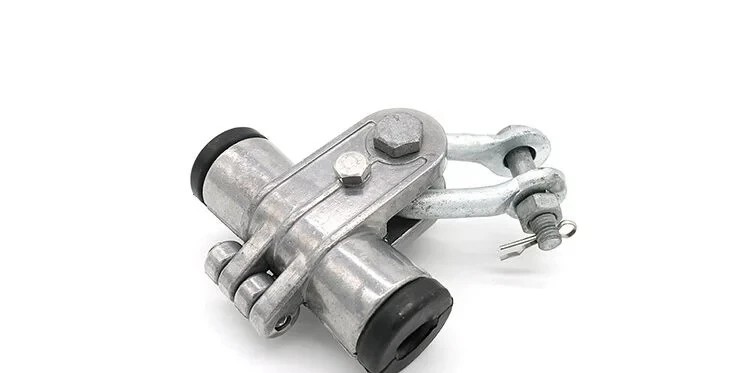
Tangent Support
The Role of Tangent Support in Cable Installation: Ensuring Safety and Stability
When installing cables—whether for electrical, telecommunications, or data transmission—proper support and stabilization are key to ensuring the system performs efficiently and remains safe over time. One of the essential tools used for this purpose is the tangent support/suspension clamps. These versatile devices are integral to maintaining the integrity of the cable installation, especially in overhead installations, such as those for power lines or telecommunications networks. In this blog, we’ll dive into the role of suspension clamps, why they are important, and how they are used in cable installation.
What is a Suspension Clamp?
A suspension clamp is a mechanical device used in overhead cable installations to support cables, especially at points where they are suspended from poles or towers. The primary function of a suspension clamp is to suspend the cable while ensuring that it remains in place and doesn't move excessively. These clamps are designed to hold the cable securely without putting undue stress on the cable itself, and they are typically used when the cable needs to change direction or navigate across distances without direct attachment to the supporting structures.
Suspension clamps are typically used for aerial installations such as high-voltage transmission lines, telephone lines, and fiber optic cables. These clamps are specifically designed to bear the weight of the cable while absorbing environmental stresses such as wind, temperature fluctuations, and mechanical loads from tension.
Why Are Suspension Clamps Important in Cable Installation?
Suspension clamps are critical for the proper functioning and longevity of cable systems. Here’s why they are essential:
-
Weight Distribution and Load Support: Cables, especially heavy-duty ones, can exert significant tension on their supporting structure. Suspension clamps help distribute the weight evenly, preventing the cable from sagging or creating additional stress points along its length. This helps maintain the structural integrity of the installation.
-
Protection Against Damage: Without proper support, cables can experience wear and tear from wind, temperature changes, and constant movement. Suspension clamps are designed to hold cables firmly, reducing movement that could lead to abrasion, fraying, or other forms of damage. By limiting excessive motion, suspension clamps help protect the cable’s insulation and internal conductors.
-
Allowing for Cable Movement: Overhead cables must often account for environmental factors such as wind, temperature changes, and even the natural expansion and contraction of materials. Suspension clamps are designed to allow some flexibility, which helps the cable adapt to these movements without risking damage or becoming overstretched.
-
Ensuring Correct Cable Alignment: When cables are suspended on poles or towers, ensuring they follow a straight and secure path is essential for their performance. Suspension clamps help keep cables aligned correctly, maintaining the necessary tension and preventing slack or uneven sagging that could affect cable performance.
-
Facilitating Long-Distance Installations: For overhead cable installations that span large distances, suspension clamps are critical in supporting cables that need to cover these vast stretches. Without proper suspension, long cable runs would be at risk of collapsing or creating unstable connections. Suspension clamps make these long-distance installations safe and feasible.
How Suspension Clamps Are Used in Cable Installation
Suspension clamps are used in a variety of ways depending on the type of cable, the environment, and the specific requirements of the installation. Below are a few key use cases for suspension clamps in cable installation:
-
Overhead Power Lines: In power transmission and distribution systems, suspension clamps are used to support the power lines on poles or towers. These clamps are designed to hold the cables in place while allowing for thermal expansion and contraction due to temperature fluctuations. They also help the cable withstand the tension generated by wind loads or environmental stresses.
-
Telecommunications Cables: Suspension clamps are commonly used in the installation of overhead telephone and fiber optic cables. These cables are often suspended between poles in urban, suburban, or rural environments. Suspension clamps ensure the cables remain in proper alignment, preventing damage that could disrupt service or lead to costly repairs.
-
High-Voltage Lines: For high-voltage electrical transmission lines, suspension clamps play an even more crucial role in stabilizing the cables. High-voltage lines carry immense amounts of current, and the strain on the supporting structure is significant. Suspension clamps ensure the cables are securely suspended while accommodating changes in weather and load, reducing the risk of sagging or disconnecting.
-
Cable Change of Direction: Suspension clamps are often used where cables change direction, such as at sharp corners or on curved cable routes. These clamps help redirect the cable without adding additional tension, and they maintain the correct cable angle, ensuring that the cable moves smoothly around bends without undue stress.
-
Cable Expansion Joints: In long cable runs, suspension clamps are used in combination with expansion joints to ensure that the cable remains securely attached to its supports but also has room to expand or contract with temperature variations. This helps prevent cable failure due to thermal stress and ensures the cable remains intact during seasonal temperature shifts.
Advantages of Suspension Clamps
-
Enhanced Durability: Suspension clamps are made from durable materials such as steel, aluminum, or composite materials, which ensure they can withstand harsh weather conditions, UV exposure, and mechanical stress.
-
Versatility: These clamps can be used in a wide variety of cable types and installations, making them an essential tool for many types of infrastructure projects, from telecommunications to high-voltage power lines.
-
Safety: By preventing cable sagging, improper alignment, or damage due to wind or other environmental stresses, suspension clamps contribute to the overall safety and reliability of cable systems.
-
Cost-Effective: Suspension clamps help prevent damage to cables, reducing the need for frequent repairs or replacements. This makes them a cost-effective solution in the long run.
Suspension clamps are an indispensable part of cable installation, particularly for overhead power lines and telecommunications networks. They provide the necessary support to ensure that cables remain secure, properly aligned, and protected from environmental stresses. By using suspension clamps, installers can ensure that the cables maintain their performance, minimize wear and tear, and extend their lifespan. Whether you're working with high-voltage lines, fiber optic cables, or any other cable type, suspension clamps are an essential tool for achieving a stable, safe, and efficient cable installation.
640
0
734
172
